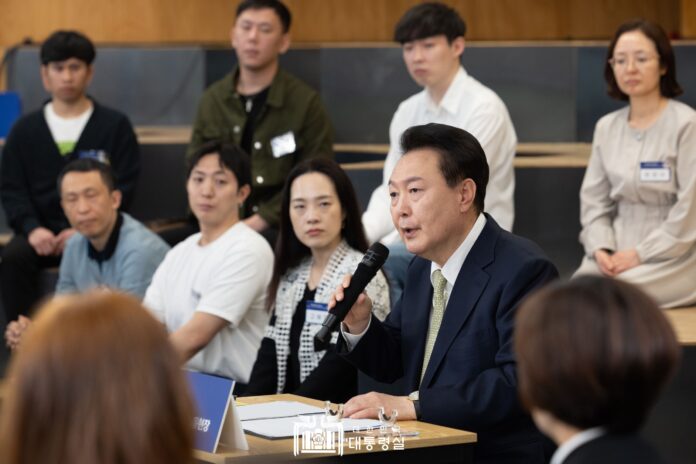
President Yoon Suk Yeol’s recent pledge to establish a specialized labor court system in South Korea has sparked a national dialogue on the potential benefits and challenges of such an institution. As the country grapples with the proposal, it is crucial to examine the experiences of other nations that have successfully implemented similar systems and to consider the implications for existing labor-related institutions in South Korea.
Labor courts have a long history in several countries, serving as dedicated judicial bodies for resolving disputes between employers and employees. Germany, for example, has had a labor court system in place since 1926. The German model is characterized by a tripartite structure, where each court consists of a professional judge and two lay judges representing employers and employees. This composition ensures that the perspectives of both parties are taken into account when deciding on labor disputes. The German labor courts have a broad jurisdiction, covering issues such as employment contracts, wages, and working conditions.
Similarly, France has a well-established system of labor courts known as “Conseils de Prud’hommes,” dating back to the early 19th century. These courts are composed of elected representatives from both employers and employees who serve as lay judges. The French labor courts focus on resolving individual labor disputes, such as wrongful termination, and place a strong emphasis on conciliation and mediation.
In the United Kingdom, employment tribunals perform a function analogous to labor courts. These independent judicial bodies, consisting of an employment judge and two lay members representing employers and employees, hear claims related to employment rights, including unfair dismissal, discrimination, and breach of contract. The lay members contribute their practical knowledge and experience of workplace issues to the decision-making process.
The common denominator among these international examples is the direct involvement of representatives from both labor and management in the judicial process. This collaborative approach ensures that the unique dynamics of labor relations are carefully considered when resolving disputes. By having a specialized court system dedicated to labor issues, these countries have demonstrated the potential for more efficient and effective resolution of labor conflicts.
Drawing from these international experiences, the introduction of labor courts in South Korea could potentially yield several benefits. Firstly, it would provide a more specialized forum for handling complex labor cases that require a deep understanding of labor laws and practices. Secondly, the involvement of representatives from labor and management could help ensure that the court’s decisions are balanced and considerate of all parties’ perspectives. Finally, a dedicated labor court system could expedite the resolution of labor disputes, which is vital for maintaining stable industrial relations.
However, the establishment of labor courts in South Korea also raises questions about the future roles of existing labor-related institutions, such as the Labor Office and the Labor Relations Commission. Currently, workers can file complaints and seek remedies for issues like wage theft through the Labor Office, while cases of unfair dismissal are handled by the Labor Relations Commission. Only after these initial steps can workers proceed with criminal charges or civil lawsuits.
If labor courts were to be introduced, it is likely that the administrative roles of the Labor Office would remain largely unchanged. The Labor Office would continue to be responsible for enforcing labor-related laws, overseeing working conditions, and supporting labor-management relations. However, the adjudicative functions of the Labor Relations Commission might be transferred to the new labor courts. In this scenario, the Labor Relations Commission could focus more on the conciliation and arbitration of labor disputes.
The experiences of other countries provide some insight into how these institutions might function alongside labor courts. In Germany, for instance, the Labor Office (Arbeitsamt) continues to play a vital role in managing unemployment benefits, vocational training, and employment services, operating independently from the labor courts. However, Germany does not have a separate body like the Labor Relations Commission, with labor courts serving as the central mechanism for resolving labor disputes.
In France, the Labor Office (Inspection du Travail) remains responsible for overseeing compliance with labor laws and promoting the improvement of working conditions, even with the presence of labor courts (Conseils de Prud’hommes). Like Germany, France does not have an equivalent to the Labor Relations Commission, with labor courts being the primary avenue for resolving labor disputes.
The United Kingdom’s Advisory, Conciliation and Arbitration Service (ACAS) plays a role similar to that of the Labor Relations Commission, focusing on the conciliation and arbitration of labor disputes. In the UK, parties are required to undergo conciliation through ACAS before proceeding to the employment tribunal, which has proven effective in resolving many disputes. Meanwhile, the Employment Agency Standards Inspectorate, akin to a Labor Office, primarily supervises private employment agencies.
As South Korea considers the establishment of labor courts, policymakers can draw valuable lessons from the successes and challenges faced by other countries with similar systems. By adapting best practices and tailoring them to the unique context of South Korea’s labor landscape, the country has the opportunity to create a more effective and efficient mechanism for resolving labor disputes and fostering harmonious industrial relations.
While the specific roles of the Labor Office and the Labor Relations Commission may evolve with the introduction of labor courts, their core functions of administrative oversight and dispute resolution are likely to remain essential. The exact nature of their roles will depend on how the labor court system is designed and integrated into the existing labor dispute resolution framework.
Ultimately, the success of labor courts in South Korea will depend on the government’s ability to engage stakeholders, learn from international best practices, and adapt them to the country’s unique context. By striking the right balance between the roles of labor courts and existing institutions, South Korea can pave the way for a more efficient, fair, and stable labor dispute resolution system.




